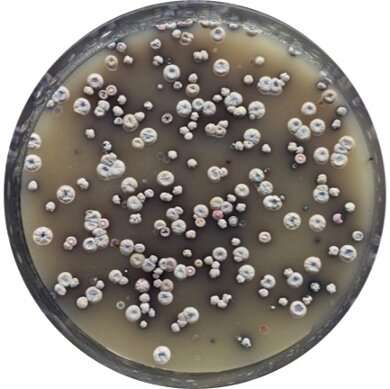Altruism in bacteria: Colonies divide the work

Bacteria found in soil specialize in the colony by division of labor. Some of the bacteria produce antibiotics, even when it comes at the expense of their individual reproduction success, to defend their colony against competitors.
Division of labor is characteristic for social groups. Well-known examples can be found in social insects such as bees and ants, that divide tasks like searching for food and taking care of offspring. Scientists from the Institute of Biology Leiden have shown that Streptomyces coelicolor bacteria also adopt specialized roles within the colony. They found that part of the bacterial colony is dedicated to producing antibiotics and other molecules. Although this comes at individual costs, the colony as a whole benefits. The researchers' findings were published in the journal Science Advances.
More antibiotics, fewer spores
First author Zheren Zhang and the research team led by associate professors Daniel Rozen and Dennis Claessen, discovered that individual S. coelicolor bacteria in a colony produced an increased amount of antibiotics while producing fewer spores at the same time. Spores increase the chance of survival when conditions are unfavorable. Producing fewer spores means a decrease in reproductive success. There turned out to be a direct negative correlation between antibiotics production and spore production. Rozen explains: "This provides evidence that producing antibiotics is a costly affair, leaving these bacteria with less energy to put into other things like producing spores."
In an S. coelicolor colony with higher antibiotics production, one would expect that the total spore production decreases. However, this turned out not to be the case. In a colony with increased antibiotics production, spore production remained the same. According to the researchers, this suggests that S. coelicolor colonies can allow for higher antibiotics production carried out by a part of the colony, without sacrificing their survival success as a group.
High mutation rate
Streptomyces coelicolor belong to a common group of soil bacteria, the streptomycetes. Due to intense competition with other microorganisms in the soil, streptomycetes defend themselves by producing many types of antibiotics. What is striking about streptomycetes is that these bacteria are subject to many genetic changes—mutations—at high speed. A colony starts from clones containing the same DNA sequence, but the high mutation rate causes many irreversible genetic differences within the colony. It appears that exactly this feature underlies the bacterium's increased antibiotics production capability.
It is not yet known which factors underlie the genetic changes in S. coelicolor. The scientists speculate this might be a byproduct of regulated cell death, in which the loss of genetic material leads to rearrangements in the genome. Competition with other microorganisms might also be a factor that alters the division of labor. Rozen: "With extra antibiotics, the colony is better able to restrain competitors in their environment. This way they increase their success as a group."
More information: Zheren Zhang et al. Antibiotic production in Streptomyces is organized by a division of labor through terminal genomic differentiation, Science Advances (2020). DOI: 10.1126/sciadv.aay5781
Journal information: Science Advances
Provided by Leiden University





















